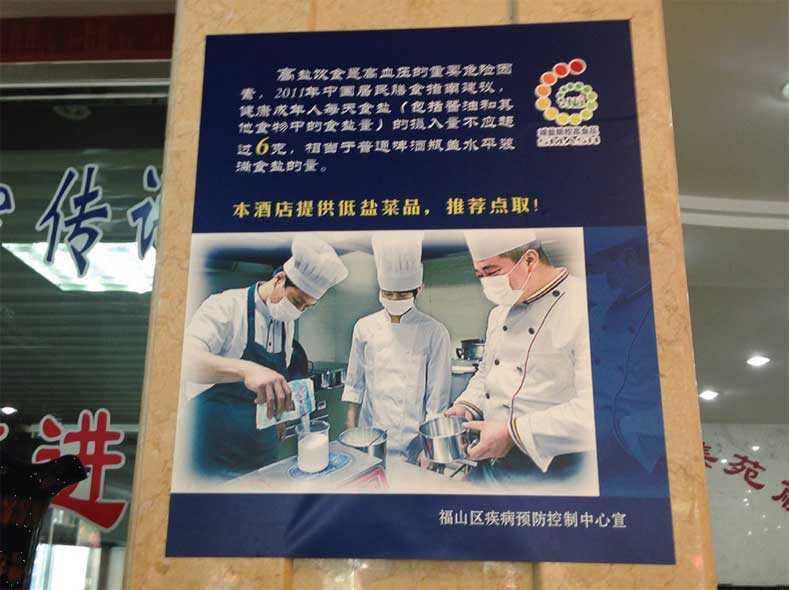Two Initiatives Worth Their Salt: Reducing Sodium Intake in Shandong, China and Philadelphia
Submitted by: Andrea Neiman, PhD, MPH, CDC, Jessica Levings, RD, MPH, and Cai Ying, MPH

On a site visit to Shandong Province in 2013, Dr. Tom Frieden listens to how restaurants are lowering salt in their menu items. Photo by: Cai Ying.
Across the world, deaths due to cardiovascular diseases (CVDs), such as heart disease and stroke, are leading causes of death in adults 25 years of age and older. Studies have shown that excess sodium intake is a key risk factor for hypertension which accounts for almost 50% of CVDs worldwide. As a result, reducing sodium intake is both a domestic and global public health priority.
In China as in the US, average sodium consumption is in excess of WHO recommendations. Main sources of sodium vary depending on the country; in China the primary source is salt added during cooking; in the US, the primary source of salt intake is through processed and restaurant foods.
Shandong Province, the third most populous province in China, has hypertension rates and salt intake in adults higher than the national average. To reduce the burden of hypertension, in 2011 China’s Ministry of Health (now National Health and Family Planning Commission) and Shandong provincial government, with technical assistance and guidance provided by US CDC, launched the first comprehensive province wide salt reduction project in China: the Shandong Province and Ministry of Health Action on Salt and Hypertension (SMASH).

Local China CDC promotes low salt cooking through media and communications. Photo by: Cai Ying.
The SMASH initiative works across broad provincial and local government agencies and health sector teams to target interventions (household and educational settings such as elementary schools and also prehypertension and hypertension populations) and strategies (such as food industry, businesses, restaurants) to reduce sodium intake.
SMASH works through restaurants to develop sodium standards for Shandong cuisine, develop and conduct chef training and lower salt menus, track salt usage, conduct chef contests for new recipes, and develop complementary communication activities to increase consumer knowledge and awareness. Restaurants that follow the lower salt requirement will be labeled as a Distinguished Restaurant. Mid-term evaluation of SMASH reported that per capita seasoning salt intake in Shandong decreased from 12.5 g to 11.58 g per day among adults aged 18-69.
Restaurants in the US also benefit from this initiative, as SMASH gains from the experience of local US efforts. After learning about US sodium reduction efforts via CDC’s Salt e-Update, a bi-weekly e-newsletter, SMASH officials have been working with Philadelphia’s Healthy Chinese Take-Out Initiative to share information on their respective sodium reduction initiatives. The Philadelphia Department of Public Health (PDPH) and Temple University’s Center for Asian Health launched the Healthy Chinese Take-out Initiative (HCTI) in 2012 to reduce the sodium content in take-out dishes by 10-15%. Owners/chefs receive cooking trainings, technical assistance and sodium resources. Additional PDPH sodium reduction efforts include a salt media campaign and implementation of nutrition standards within City departments.
As part of this information sharing, Shandong provided Philadelphia with CDC sodium fact sheets translated to Chinese. These materials assisted Philadelphia in communicating health information more effectively with participating restaurant operators who do not speak English. This collaboration has also brought together other opportunities, including a site visit from the Shandong province officials to Philadelphia in 2014, a joint presentation at the American Public Health Association meeting, November, 2015, and plans for an international consultation focused on sodium reduction efforts globally in 2016.
While the US continues to make substantial progress in achieving national CVD goals, there remains great opportunity to achieve more. Active engagement with global partners provides the unique opportunity to share CDC’s expertise and knowledge, and also leverage existing global efforts to enhance learning capacity and improve domestic approaches. SMASH and Philly’s Healthy Chinese Take-out Initiative share similar goals and approaches; they are leveraging resources, and experiences to enhance their respective programs.
For more information, contact: Andrea Neiman at aneiman@cdc.gov.
Related Links
- Page last reviewed: September 28, 2015
- Page last updated: September 28, 2015
- Content source:
Global Health
Notice: Linking to a non-federal site does not constitute an endorsement by HHS, CDC or any of its employees of the sponsors or the information and products presented on the site.


 ShareCompartir
ShareCompartir